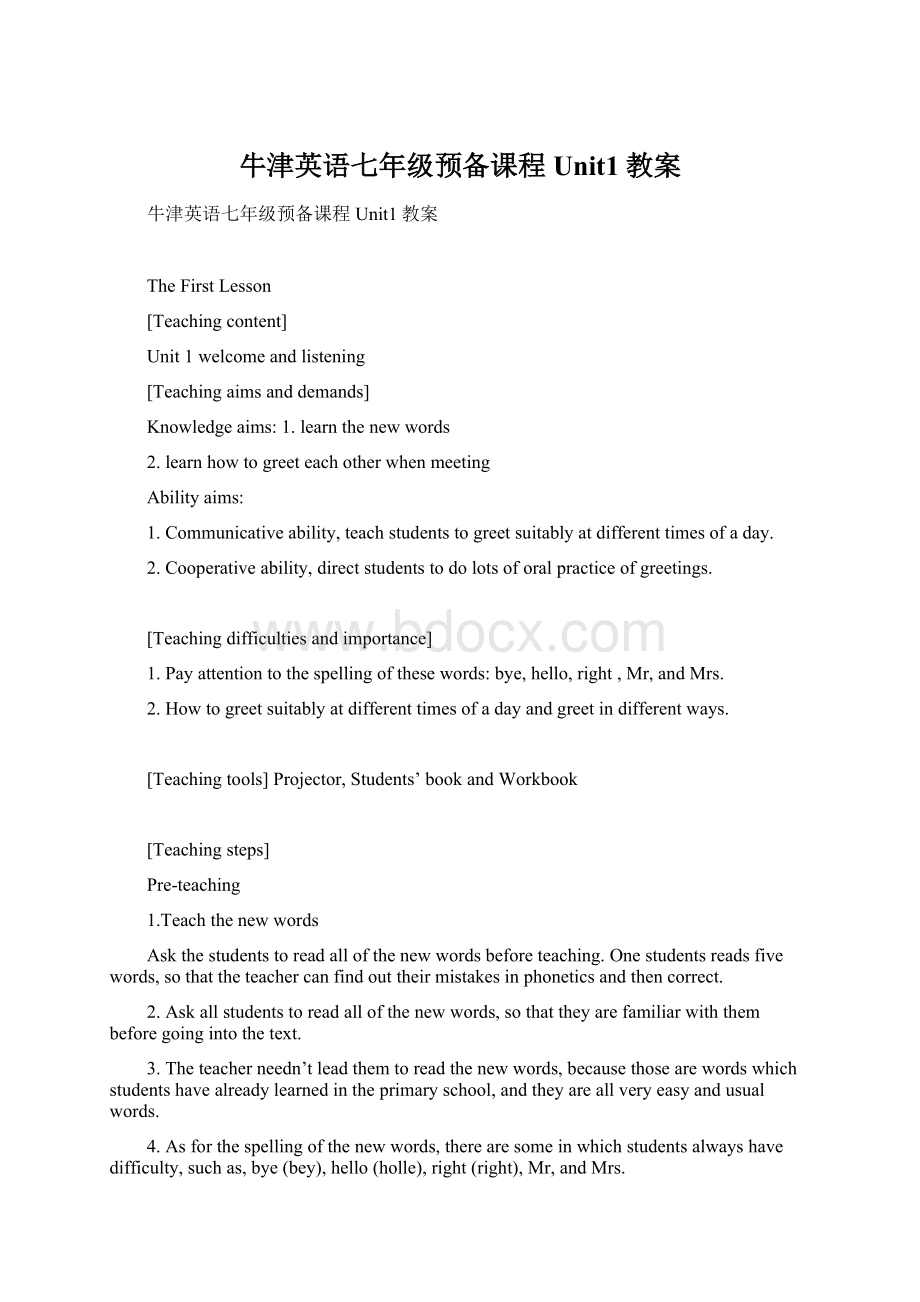牛津英语七年级预备课程Unit1教案.docx
《牛津英语七年级预备课程Unit1教案.docx》由会员分享,可在线阅读,更多相关《牛津英语七年级预备课程Unit1教案.docx(58页珍藏版)》请在冰豆网上搜索。

牛津英语七年级预备课程Unit1教案
牛津英语七年级预备课程Unit1教案
TheFirstLesson
[Teachingcontent]
Unit1welcomeandlistening
[Teachingaimsanddemands]
Knowledgeaims:
1.learnthenewwords
2.learnhowtogreeteachotherwhenmeeting
Abilityaims:
1.Communicativeability,teachstudentstogreetsuitablyatdifferenttimesofaday.
2.Cooperativeability,directstudentstodolotsoforalpracticeofgreetings.
[Teachingdifficultiesandimportance]
1.Payattentiontothespellingofthesewords:
bye,hello,right,Mr,andMrs.
2.Howtogreetsuitablyatdifferenttimesofadayandgreetindifferentways.
[Teachingtools]Projector,Students’bookandWorkbook
[Teachingsteps]
Pre-teaching
1.Teachthenewwords
Askthestudentstoreadallofthenewwordsbeforeteaching.Onestudentsreadsfivewords,sothattheteachercanfindouttheirmistakesinphoneticsandthencorrect.
2.Askallstudentstoreadallofthenewwords,sothattheyarefamiliarwiththembeforegoingintothetext.
3.Theteacherneedn’tleadthemtoreadthenewwords,becausethosearewordswhichstudentshavealreadylearnedintheprimaryschool,andtheyareallveryeasyandusualwords.
4.Asforthespellingofthenewwords,therearesomeinwhichstudentsalwayshavedifficulty,suchas,bye(bey),hello(holle),right(right),Mr,andMrs.
Step1.Warm-upandPresentation
MakeSsrecallthegreetingswhichtheylearnedintheprimaryschoolbydoingsomecommonandeasygreetingswithstudents,leadingtothesubjectofthisunit.
Step2.Welcometothisunit
1. Askstudentstoreadthefourdialoguesofthispartfortwice,andgetreadyforthefollowingquestionstocheckifthestudentsunderstandthemeaningofthedialogues:
WhoisAndy?
WhoisMillie?
WhoisLily?
WhoisNick?
WhoisMissFang?
Whentheymeet,whatdotheysay?
Whentheymeetinthemorning,whatdotheysay?
Whentheypart(分别),whatdotheysay?
2. Teachstudentssomesimilarwordsandsimilarsentencesofthefourdialogues,andatthesametimeaskthemtoreplaceallofthenamesinthedialogueswiththethosesoftheirclassmates.Therefore,studentscanmakeanotherfourdialoguesoftheirownandofdifferentpatternsbutofthesamemeaning.
Forexample,Hi=Hello,Goodmorning=Goodmorningtoyou,
Goodbye=Bye-bye,Bye,Seeyou,seeyouaround,seeyoulater
3. Pairworkandashowtime
Step3Listening
1. Pre-listening.
ThereisaclockonthewallinPicture1ofPartA,soaskSsforthecorrecttime.Afterthattheteacherguidesthestudentstoobservethetimesoftheotherthreedialoguesinthispartandteachesthedifferentwaysofgreeting.
2. Askstudentstodothelisteningexercisesonthetapeandtickthecorrectanswer.
3. Dosomepost-listeningwork.Guidestudentstoreplaceallofthenamesinthedialogueswiththenamesoftheirclassmatesandusesomesimilarwordsandsimilarsentencestomakeanotherdialogueoftheirown,sothatSscanknowthedifferentwaysofgreeting.
Forexample,Goodafternoon=Goodafternoontoyou,Howareyou=Howareyoudoing,
I’mfine=I’mOK,OK,Fine,Good,Great,hi=hello,Andyou=Whataboutyou,
Thankyou=Thanks
4. Pairworkandashowtime
5.Summary,askSstofindandlearnthesedifferentwaystogreeteachother.
1).Youknoweachother:
Hi,goodmorning/afternoon;Howareyou?
2).Youdon’tknoweachother:
Hello,what’syourname?
3).Youdon’tknoweachother,butyouknoweachother’sname:
Hello,you’re----,right?
Step4Furtherknowledgeandability
1. Howareyou?
的回答一般是肯定,它的不同回答有:
Fine,thankyou./I'mfine,thankyou./Notbad,thankyou./I'mOK/verywell/Allright.
/Justso-so.
身体状况确实不好,我们可以说:
Notsogood/Terrible/Idon’tfeelingverywell.
2.对女性和男性的称呼如下:
对男性我们一律称Mr.soandso,对未婚女性我们称Misssoandso,而对已婚和不明婚姻状况的女性分别称Mrs.soandso,和Mssoandso.,并将Mr.Mrs.或Miss,Ms放在姓之前。
4. 26个字母中有Aa,Ee,Ii,Oo,Uu5个元音和21个辅音。
Step5.dotheworkbook
Step6.Homework
1.Writeadialoguebetweentwostudentswhodon’tknoweachother.
2.Singasong“Hello!
”
TheSecondLesson
[Teachingcontent]
Unit1Speaking,ThealphabetandListening
[Teachingaimsanddemands]
Knowledgeaims:
1.reviewnewwords
2.LettersA--N,thecorrectorderofthem,andtheirwritingmethods
3.PhoneticsymbolsofLettersA--N,thewordswhichtheyrepresent
Abilityaims:
1.Communicativeability,teachstudentstogreetsuitablyatdifferenttimesofaday.
2.Cooperativeability,directstudentstodolotsoforalpracticeofgreetings.
[Teachingdifficultiesandimportance]
1.Howtogreetsuitablyatdifferenttimesofadayandgreetindifferentways
2.thecorrectorderofLettersA--N,theirwritingmethods
3.Studentshavegreatdifficultyinthefollowingtwosentences:
YouareNick,right?
AreyouNick?
You'reJill,right?
该句的回答跟一般疑问句的回答相同。
如果符合事实情
况就说Yes,Iam.,反之,就是No,(I'mnot.)I'mxxx.
[Teachingtools]Projector,Students’bookandWorkbook
[TeachingSteps]
Step1.Revision
1.reviewnewwordsofboththeirspellingandtheirsound.
2.Theteacherhassomedialogueswithsomestudentsindifferentsituations
Step2.Speaking
1. Askthestudentsreadthedialoguesinthispart,andcorrecttheirmistakesinphonetics.
2. Directthemtoplaytheroleinordertobefamiliarwiththestructureofthedialogue.
3. Guidestudentstoreplaceallofthenamesinthedialogueswiththenamesoftheirclassmatesandusesomesimilarwordsandsimilarsentencestomakeanotherdialogueoftheirown.
Forexample,What’syouname?
=MayIknowyourname?
Canyoutellmeyourname?
4. Pairworkandgivestudentschancestoshowtheirdialogues.
5.Themostdifficultpoint
Ssmakemistakeseasilyinthefollowingtwosentenceswhichhavethesamemeaning:
YouareNick,right?
和AreyouNick?
Theyarealwayspuzzledwiththeorderof“YOU”and“ARE”
You'reJill,right?
该句的回答跟一般疑问句的回答相同。
如果符合事实情况就说Yes,Iam.,反之,就是No,(I'mnot.)I'msoandso.
Inordertoovercometheobstacle,theteacherhastoaskSstodolotsofrepeatingworkorallyanddomuchcopywork.Besides,doexercisetorearrangetheorderofthesentence.
Step3.Reading
1.Askstudentstoreadthedialogueinthispartbythemselvestwiceandgetreadyforthesequestions:
What’sthenameofthegirl?
What’sthenameofhermother?
What’sthenameofthewoman?
Whatdotheysaywhenthewomanmeetsthegirl?
2.Guidestudentstoreplaceallofthenamesinthedialogueswiththenamesoftheirclassmatesandusesomesimilarwordsandsimilarsentencestomakeanotherdialogueoftheirown.
Forexample,What’syouname?
=MayIknowyourname?
Canyoutellmeyourname?
3.Pairworkandgivestudentschancestoshowtheirdialogues.
Step4.Thealphabet
1.TeachstudentsthesoundofLettersA--N,thecorrectorderofthem,andtheirwritingmethods.
2.Accordingtothepictures,directstudentstolearnsomewordsbeginningwiththeseletters,thatistheirphoneticsymbols:
apple;ball;cat;dog;egg;fish;girl;hat;ice-cream;juice;kite;like;mouse;nose
Payattentiontotheirspelling.
3.Introducetheseabbreviations:
UK,CD,a.m,cm,mm,kg,ID,KFC,NBA,LG,BBC,CCTV,CBA,VOA,andaskSsabouttheirmeaning.Tellthemtopayattentiontowhethercapitallettersareneeded.
4.Guidestudentstofindmoreabbreviations,andasksomestudentstoshowthemontheblackboard.ThereareMBA,LG,BBC,ABC,AD,BC,BA,BEC,CAAC,CBA,CBC,OK.
Step5Task,aguessinggame
Step6Dotheworkbook
Step7Homework
1.CopythenewwordsandalldialoguesofUnit1,andpreparedfordictations
2.AskSstofindmoreabbreviations.
Unit9 Signs 教材分析
一.本单元在全书中的地位、作用分析
在前面八个单元学完名词的单复数、谓语的单复数、祈使句、therebe结构、表示位置关系的介词、人称代词的主宾格、形容词性物主代词、名词性物主代词的基础上,本单元继续学习基本语法:
情态动词can和must.因为情态动词的句型转换和句中有be的句子一样,相对比较简单,就是疑问句把情态动词提前,否定句加not,学生比较容易理解掌握,为下一个单元学习第一种句型转换需要借助于助动词的,也是第一种时态的——“一般现在时”打基础。
二.本单元的教学重点
1.情态动词can和must的用法
情态动词can和must的用法并不难,就是后面跟动词原型,没有人称和数的变化。
2.学习一些重要的动词词组,如:
watchTV,listentomusic,flykites,rideabike,smoke,useabook,bringmybaghere
3.学习几个重要的交际用语:
Great!
Let’sgo. Whynot?
Whycan’tIbringmydoghere?
和Isee.
4.学习一些有关交通规则的常识,并尽量用英语表述。
三.本单元的教学难点
1.要向学生讲明,can的含义不止一种,用法都是后面跟动词原型,没有人称和数的变化:
1)表示请求和许可,例如:
CanIbringmybaghere?
Youcan’tplayfootballhere.
2)表示某人做事的能力,例如:
Icanswim.
2.must的否定回答特别不容易掌握。
如果用must提问,肯定回答说Yes,youmust.否定回答要说No,youneedn’t.
不能用must的否定形式mustn’t,因为mustn’t表示“不许”,含义接近于can’t
3.在Speaking部分,会碰到这个语法:
否定句中并列成分之间用or连接,如果后一句也有not,那么才用and连接。
四.建议解决重点难点的方法
1.对于情态动词can和must的用法,要求学生对Welcome部分和Speaking部分都做模仿对话,不但口头做,而且回家作业,布置书面编写对话。
或者,给出can和must,叫学生进行想象造句。
2.利用Reading课文进行问答,也可以加深对情态动词can和must用法的了解。
课文了解之后,用多媒体设备,只给出Reading部分的图片,不允许看书,叫学生复述课文。
3.利用班规、校纪,进行师生问答,可以对情态动词达到学以致用的效果。
4.Speaking的替换部分,课本提示了四个词,并且还有四个图片。
在做模仿对话之前,可以叫学生用can或can’t对提示的词和图片先造句。
结果肯定学生会造出Youcan’teatanddrink这样的句子来,教师借机教授,否定句中并列成分之间用or连接,如果后一句也有not,那么才用and连接。
然后叫学生运用这个语法,对提示的词和图片造出更完美的句子,并运用到接下来的模仿对话中。
5.对于must的否定回答的处理:
再三强调,如果用must提问,肯定回答说Yes,youmust.否定回答要说No,youneedn’t.
要求学生做笔记、多读背,并且教师多提问要学生回答,最后,多做练习题,加以熟练。
Unit10 Myschoolday 教材分析
一.本单元在全书中的地位、作用分析
通过前面九个单元基础语法的学习,本单元学习第一种时态“一般现在时”终于现身了,这个时态的含义、用法和结构,一直是学生的心腹大患,正因为如此,后两个单元的语法专题仍然是一般现在时,意图是不断加以复现、巩固。
二.本单元的教学重点
1.掌握句型:
(1)Whattimeisit?
(2)Whatdayisittoday?
(3)Whenisyour…lesson?
(4)Whattimedoyou…?
2.学习时刻的不同表示方法。
3.学习一般现在时的用法和结构,了解频率词的概念和最常用的频率词,并学会用一般现在时简单表述自己在一天中的活动。
三.本单元的教学难点
1.一般现在时的表示“现在经常做的动作”,这是它和其它时态最大区别,常和频率词连用。
2.一般现在时态,谓语的形式要根据主语而变化,规则是:
主语单数,谓语加s,主语复数,谓语用原形,I和you,用原形。
3.一般现在时的一般疑问句和否定句,肯定回答和否定回答也是难以学会的内容。
4.关于时刻的不同表示方法,如:
seventhirty相当于